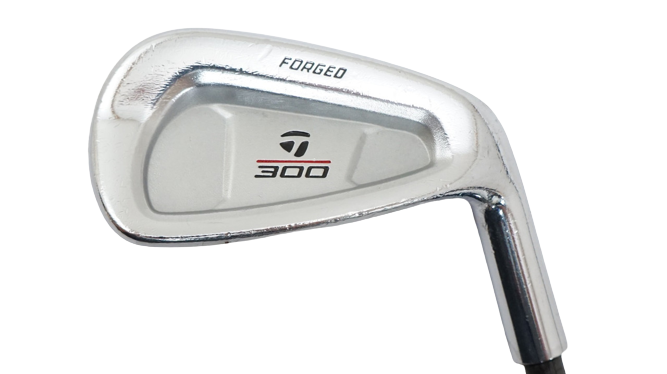Are Taylormade 300 Irons Still Good? Are They Forgiving for High Handicappers?

“The Taylormade 300 irons have a very era-evocative design.”
You don’t really see the kind of shaping and features that the Taylormade 300’s bear in modern Taylormade irons.
And at first, it’s hard to say if that’s a good thing or a bad thing. Usually, when a golf club manufacturer finds a design that works, they stick with it for as long as they can. So it begs the question, “why don’t we see irons designed like the Taylormade 300’s anymore?” Was something amiss with these irons?
On the flipside, sometimes golf club companies inexplicably discontinue a very popular line of clubs. I guess sometimes they just want to shake things up. In any case, I wanted to get to the bottom of the Taylormade 300 irons. Is there a good reason they don’t make these irons anymore or are they still valuable for high handicappers?
Are the Taylormade 300 Irons Still Good?
“The first thing you should know about these irons (and what should give you an idea of their quality) is that they are forged from carbon steel.”
On top of that, the Taylormade 300 irons underwent the special “double-strike” forging process that defined Taylormade forged blades of this era. Right away, I fell in love with the way these irons felt. They provide the soft feel you would expect from carbon steel but they still feel plenty solid at impact. Overall, it’s a very addictive feeling that will keep you swinging.
The second thing you should know is that these are relatively compact blades. There is only a touch of offset and the top line is thin. And while these are technically cavity back blades, the cavity is filled with a backing plate that Taylormade calls the “impact pad.”
At address, these irons look really nice. The undercut cavity is fairly deep and you can only see it stick out in the longer irons. After that, everything is tucked away nicely and all you’re left with are clean, uninterrupted lines. The Taylormade 300 irons don’t look extremely forgiving at address; but that is usually the price you pay for cleaner looking blades.
The Taylormade 300 irons also feature the “U Grooves” that are said to impart more spin to the ball throughout the set. I’m inclined to agree. During my testing, I found that I was able to put spin on the ball at will even with the long irons.
The Taylormade 300 irons don’t launch like compact blades though. The 9-iron comes in at a towering 43° which is fine because the cavity undercut shrinks by the time you get to the scoring irons. In the longer irons though, the weak lofts may present ballooning issues depending on your swing.
The Taylormade 300 irons weren’t exactly made for distance but the key is consistency. You don’t really need your 7-iron to blast past 180 yards. The important thing is that you get even gapping and consistent distance from your irons. And that’s exactly what the Taylormade 300 irons offer. They won’t make your 6-iron play like a 5-iron; but you know what you can expect from them every time.
Are the Taylormade 300 Irons Forgiving for High Handicappers?

“The Taylormade 300 irons will give you tight dispersion and increase your accuracy as long as you are moderately accurate with your swing.”
There isn’t a ton of sweet spot real estate on these irons. But they aren’t butter knives. If you can make semi-consistent contact, you will find that the Taylormade 300 irons offer very tight dispersion.
With the 7-iron, my off-line divergence never drifted past 7 yards. I was landing just right of the target for the most part. The CG of these irons may be progressive but the weighting is neutral. This meant that I could achieve my desired baby draw without altering my swing with these irons.
Going back to the progressive CG, I think this will be helpful for high handicappers. It makes the long irons a lot easier to launch while tapering the towering launch in the short irons. This offers a very dynamic range of performance that, regardless of what some coaches preach, is a benefit to players of all skill levels.
Are the Taylormade 300’s the most inherently forgiving irons I’ve ever tested? No. But there are basic forgiveness features that will still be useful for the high handicapper who is committed to breaking into mid handicap territory.
Taylormade 300 Vs Taylormade SIM Max Irons
“The Taylormade SIM Max irons definitely provide more distance than the Taylormade 300’s.”
But there was definitely less distance control in them. They have super-thin, unsupported faces. And while this design pouches ball speeds up, it also makes the SIM Max irons a bit unpredictable. I personally preferred the consistency of the Taylormade 300 irons.
Taylormade 300 First Impressions

“I was enamored by the feel of these irons right away.”
Based on the feel alone, I can’t imagine a reason they would discontinue these irons. Feedback is clear as a bell and despite being soft, they still feel substantial.
Taylormade 300 Selling Points
- Forged
- 8620 construction
- U-Grooves
- Impact pad
- Angled soles
Taylormade 300 Key Technology
Impact Pad
The impact pad is a cavity insert that is supposed to increase face flexion and distance.
Angled Soles
The thin, angled soles of these irons make for fairly smooth turf interaction.
U-Grooves
The aggressive and durable U-grooves allowed me to put spin on the ball from distance.
Taylormade 300 Loft & Lie
| Club | Loft (degrees) | Lie (degrees) |
| 1-iron | 17 | 57 |
| 2-iron | 19 | 58 |
| 3-iron | 21 | 59 |
| 4-iron | 24 | 60 |
| 5-iron | 27 | 60.5 |
| 6-iron | 31 | 61 |
| 7-iron | 35 | 61.5 |
| 8-iron | 39 | 62 |
| 9-iron | 43 | 62.5 |
Who Should Buy the Taylormade 300 Irons?

“The Taylormade 300 irons are best for mid and low handicappers.”
The cavity back creates perimeter weighting which enhances forgiveness; but I wouldn’t recommend the Taylormade 300 irons to any high handicapper who wasn’t dead set on lowering their score.
Distance: 96/100
Forgiveness: 95/100
Workability: 98/100
Overall Performance: 97/100
Value: 97/100





